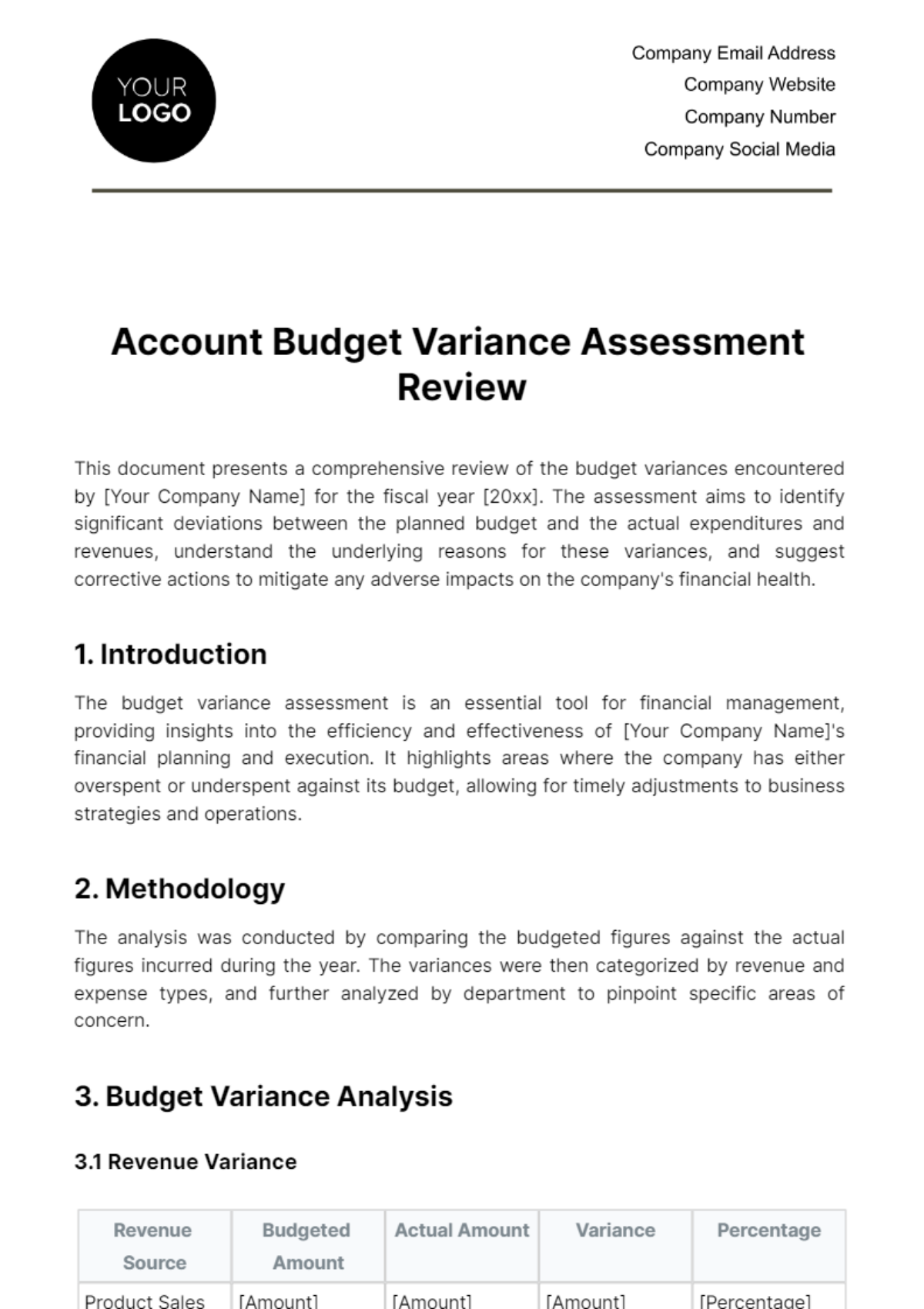Free Account Budget Variance Assessment Review

This document presents a comprehensive review of the budget variances encountered by [Your Company Name] for the fiscal year [20xx]. The assessment aims to identify significant deviations between the planned budget and the actual expenditures and revenues, understand the underlying reasons for these variances, and suggest corrective actions to mitigate any adverse impacts on the company's financial health.
1. Introduction
The budget variance assessment is an essential tool for financial management, providing insights into the efficiency and effectiveness of [Your Company Name]'s financial planning and execution. It highlights areas where the company has either overspent or underspent against its budget, allowing for timely adjustments to business strategies and operations.
2. Methodology
The analysis was conducted by comparing the budgeted figures against the actual figures incurred during the year. The variances were then categorized by revenue and expense types, and further analyzed by department to pinpoint specific areas of concern.
3. Budget Variance Analysis
3.1 Revenue Variance
Revenue Source | Budgeted Amount | Actual Amount | Variance | Percentage |
|---|---|---|---|---|
Product Sales | [Amount] | [Amount] | [Amount] | [Percentage] |
Services | [Amount] | [Amount] | [Amount] | [Percentage] |
Other Income | [Amount] | [Amount] | [Amount] | [Percentage] |
Total | [Amount] | [Amount] | [Amount] | [Percentage] |
3.2 Expense Variance
Expense Category | Budgeted Amount | Actual Amount | Variance | Percentage |
|---|---|---|---|---|
Salaries | [Amount] | [Amount] | [Amount] | [Percentage] |
Marketing | [Amount] | [Amount] | [Amount] | [Percentage] |
Operations | [Amount] | [Amount] | [Amount] | [Percentage] |
R&D | [Amount] | [Amount] | [Amount] | [Percentage] |
Total | [Amount] | [Amount] | [Amount] | [Percentage] |
4. Detailed Variance Analysis by Department
Sales Department: Exceeded revenue expectations by [Percentage], mainly due to an increase in product sales volume. However, there was a [Percentage] shortfall in service revenue due to delayed contract renewals.
Marketing Department: The [Percentage] increase in marketing expenses was largely due to an unplanned social media campaign aimed at boosting end-of-year sales.
Operations Department: Operational expenses were [Percentage] below budget, thanks to cost-saving measures implemented throughout the year, including negotiations for lower utility rates.
R&D Department: The R&D expense exceeded the budget by [Percentage], reflecting the company's investment in new product development which was not originally planned.
5. Recommendations
Increase Focus on Service Sales: Implement strategies to enhance service sales, including promotion and client engagement initiatives.
Budget Adjustment for Marketing: Review marketing strategies and allocate budget more efficiently to avoid overspending.
Continue Cost-saving Measures in Operations: Maintain the cost-saving practices that led to a favorable variance in operational expenses.
Strategic Investment in R&D: Support the R&D department's over-budget spending as an investment in future growth, but monitor closely to ensure that projects align with long-term strategic goals.
6. Conclusion
The budget variance assessment for [Your Company Name] revealed both positive and negative variances across different departments. By addressing the underlying causes of these variances, [Your Company Name] can better align its financial planning with strategic goals, ensuring sustainable growth and profitability in the coming years.
- 100% Customizable, free editor
- Access 1 Million+ Templates, photo’s & graphics
- Download or share as a template
- Click and replace photos, graphics, text, backgrounds
- Resize, crop, AI write & more
- Access advanced editor
Presenting the Account Budget Variance Assessment Review Template from Template.net, designed for precision in financial analysis. This fully editable and customizable template offers professionals a structured approach to identify, analyze, and address budget variances. It ensures accurate assessment of financial performance against budgeted expectations which is editable using our Ai Editor Tool only at Template.net.





























